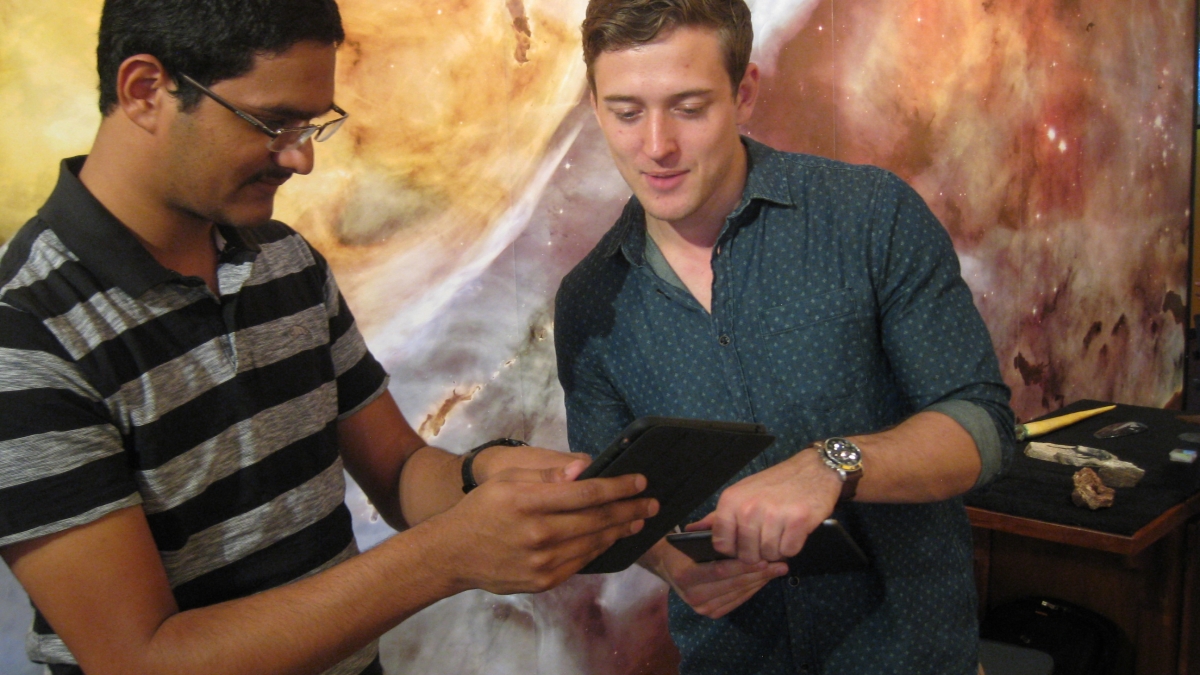ASU-developed app gives museum visitors an astronaut in the palm of their hand

Two Arizona museums will soon add an astronaut as a docent – a digital docent called “Dr. U.”
The Arizona Science Center and the Arizona Museum of Natural History are partnering with Arizona State University to offer visitors an app to complement their exhibits. Dr. Universe, a mobile app, encourages museum visitors to ask questions and the astronaut responds back from its database.
Dr. Universe is a project spearheaded by students and faculty in the School of Earth and Space Exploration and the School of Computing, Informatics and Decision Systems Engineering. A team of engineering students worked on programming as earth and space exploration and biology students created content – a student from the Herberger Institute from Design and the Arts designed the visuals.
Judd Bowman, associate professor at the School of Earth and Space Exploration, said during his wife’s graduate school career, she researched whether it’s possible to have a mentor relationship with a computer in an educational environment. Within the last three years, Bowman said he noticed how museum staff need help in evaluating its visitors’ experiences.
“It seemed like a natural fit to take this idea of a ‘computerized scientist’ and let people have it within the museums and let people ask questions with it,” Bowman said.
Bowman said museum exhibits tend to have a long lifetime, but they aren’t always updated as quickly as science advances. The app, funded by the National Science Foundation, currently covers more than 12,000 questions on various topics from astronomy to geology. Bowman said he and the team, which includes Cassie Bowman and Brian Nelson, both faculty, collected many of the questions three years before the development of Dr. Universe. Museum staff will also have access to a dashboard that aggregates the popular topics and questions being asked on the app.
“The idea is it’s a trusted database of information,” Bowman said. “It’s been screened through us, through our students. You know it’s going to be safe for kids, safe for your family members to use it. It’s not just whatever Google happens to bring up.”
Kyle Rogers, a geological science senior, said he goes to the two museums and figures out what content to develop based on the open exhibits. He also talks with the docents to see what questions are commonly asked. In addition to information provided by the museum, Rogers also utilizes textbooks, government websites and peer reviewed articles.
Rogers said he’s worked on approximately 2,500 questions in the past four months. With the previous database and his work, Rogers said currently the database houses around 12,000 Q&As in English. He works about 10 hours a week.
“It’s a great project because it’s furthering someone’s education,” Rogers said.
Ivan Fernandez, biological sciences junior, translates the questions, and Itxier Meziani, earth and space exploration senior, works on translating the answers. Meziani said she spends about 10 hours a week translating the answers.
Meziani said she conducts a lot of research to find the right word because certain words don’t translate exactly into Spanish. Meziani said she’s translated 4,000 answers so far in Spanish. She also helped Fernandez translate questions, and she said it takes her about one hour to translate 200 questions.
Dheeraj Yennam, a computer science senior, said his group chose the project because of the flexibility it provided. The engineering students meet up weekly with the professors to talk about their progress and best next steps.
“They’re asking us for our opinion instead of telling us their opinion and to do it,” Yennam said. “We appreciate that as programmers.”
He said their group has enjoyed working on the project that they use some of their own time to put in extra hours.
The Dr. Universe team had their first testing of the app earlier in the semester at the Arizona Museum of Natural History. Bowman said it was a good testing experience because they had the real museum environment. It helped the whole team see if the speech detection worked in a loud environment or if its design for the iPad mini provided a good feel.
Meziani said that the trial run at the museum went well for the Spanish portion. However, there still needs to be work done for the microphone to catch Spanish accents.
“I was really surprised how much people have done on this application,” Meziani said. “We were able to talk back, and I even had my kids try it, and they loved it.”
The next trial run will incorporate another feature involving iBeacons placed throughout the exhibits that will track when a user is nearby. Bowman said in one exhibit they noticed how photographs' descriptions were in English but not Spanish. If the beacon recognizes the app, it could do something like pull up the Spanish descriptions.
Yennam said they have the bluetooth beacons ready to be tested. He said the beacons have been tested in smaller rooms, but he isn’t sure how it will work in a larger environment.
He said the team is excited that there is potential for the app to expand to other museums. Yennam said the museum staff seem impressed that a user could speak into it and there wouldn’t be spelling errors.
The project is set to last for three years, but Bowman said he hopes it develops into a product that many museums use and tailor to their content.
“This project is a really cool example of ASU getting into the community, students getting involved with the museums and seeing how the things they’re learning and the work they’re doing here applies in that context,” Bowman said.
Written by Alicia Canales
Media contact: